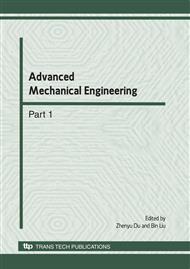[1]
Tien F C, Yeh C H and Hsieh K H. Automated visual inspection for micro-drills in printed circuit board production [J]. International Journal of Production Research, 2004, 2(12): 2477-2495.
DOI: 10.1080/00207540310001659656
Google Scholar
[2]
HU Songli, XU Li-ming and XU Kai-zhou, et al. Adaptive Contour Corner Detection of Micro-drill's First Facet [J]. Journal of Shanghai Jiao Tong University. 2009, 43(5): 825-829.
Google Scholar
[3]
HUANG Fugui, CUI Changcai. New Method for Evaluating Arbitrary Spatial Straightness Error[J]. Chinese Journal of Mechanical Engineering, 2008, 44(7): 221-224. (In Chinese).
DOI: 10.3901/jme.2008.07.221
Google Scholar
[4]
JIA Lide, ZHENG Ziwen and LI Shengyi, et al. Measurement Method of Straightness Error of a Long Ultra-precise Guideway with a Short Benchmark[J]. Chinese Journal of Mechanical Engineering, 2008, 44(9): 141-147. (In Chinese).
DOI: 10.3901/jme.2008.09.141
Google Scholar
[5]
HUANG Fu-gui, CUI Chang-cai. Comparison of evaluating precision of straightness error between least square method and least envelope zone method[J]. Optics and Precision Engineering, 2007, 15(6): 889-892. (In Chinese).
DOI: 10.1109/iita-grs.2010.5603259
Google Scholar
[6]
Sanger T D. Optimal Unsupervised Learning in a Single-Layer Linear Feedforward NN. Neural Networks, 1989, 2: 459-473.
DOI: 10.1016/0893-6080(89)90044-0
Google Scholar
[7]
S. Y. Kung. et al. A Neural Network Learning Algorithm for Adaptive Principle Components Extraction(APEX). Proc ICASSP, 1990, 2: 861-864.
Google Scholar
[8]
State L., Cocianu C., Vlamos P., et al. Neural approaches to image compression/decompression using PCA based learning algorithms[C]. Proc. Int. Workshop Pattern Recogn. Inf. Syst. - PRIS 2008, 187-192.
DOI: 10.5220/0001728701870192
Google Scholar
[9]
Palmieri F, et al. Anti-Hebbian Learning Algorithm for Adaptive Principle Components Extraction. Proc ICASSP, 1990, 2, 861-864.
Google Scholar
[10]
Hasan M. A., Hasan J. A. K. Sanger's type dynamical systems for canonical variate analysis[C]. Proceedings of the 2008 American Control Conference, 4087-4092.
DOI: 10.1109/acc.2008.4587133
Google Scholar
[11]
J. Canny. A Computational Approach to Edge Detection [J]. IEEE. Transactions on Analysis and Machine Intelligence, 1986, 8(6), 679-698.
DOI: 10.1109/tpami.1986.4767851
Google Scholar
[12]
Lin, C. C., Chen, Y. H. and Chang, C. C. LSB-based High-Capacity Data Embedding Scheme for Digital Images [J], Inter. Journal of Innovative Computing, Info. and Control. 5(11B): 4283-4289, (2009).
Google Scholar


